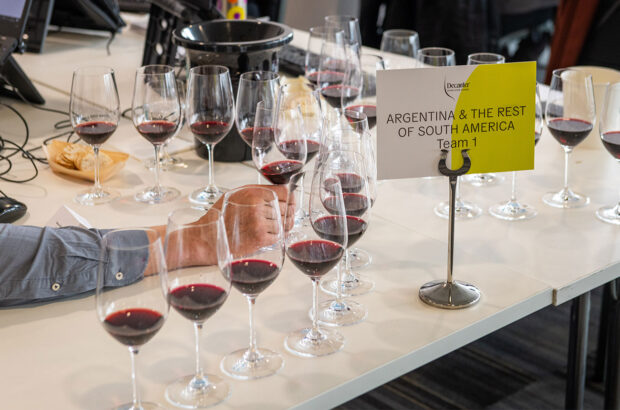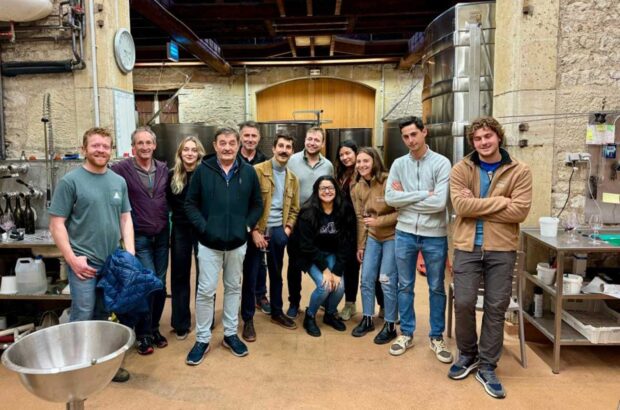Although it’s not an Italian native, Pinot Noir thrives in certain cool-climate spots across the country. Walter Speller charts its progress and recommends some of the best examples...
Italy’s top Pinot Noirs
Key facts: Italian Pinot Noir
Total hectares planted 5,044ha in 2010 (3,314ha in 2000)
Largest total surface 2,956ha in Lombardy’s Pavia for the production of base wine for the sparkling wine industry in Italy’s north; Franciacorta’s total is 387ha. South Tyrol and Trentino boast 553ha of Pinot Noir, and increasing
Aspect The key to success with Pinot Noir is high altitude, followed by north and west vineyard expositions
Styles Savoury and mineral in alpine areas like South Tyrol and Valle d’Aosta; dense yet elegant and ageworthy in Tuscany’s Apennine Mountains
‘My wish has always been to make a La Tâche 1953: elegance combined with power, and varietally pure.’ I am with Franz Haas, veteran wine producer in alpine South Tyrol, who has just poured me a glass of Pònkler, his beautiful single-vineyard Pinot Noir planted at an incredible density of 10,000 vines per hectare at 750m, high up in the Alps. When I protest, saying it doesn’t make sense to pursue this in a radically different terroir, he corrects me: ‘Of course my guiding light is Burgundy. I need that guiding light to find out what I can achieve in South Tyrol.’ But rather than Burgundy, cool climate seems to be the key principle that lies behind Pònkler.
{"content":"PHA+RnJvbSBoaXMgbW90aGVyLCBIYWFzIGluaGVyaXRlZCBhIHZpbmV5YXJkIGluIE1hem9uIOKAkyBhIHNvdXRod2VzdC1mYWNpbmcgcGxhdGVhdSBhdCA0MDBtLCB3aGljaCB3YXMgaGlzdG9yaWNhbGx5IGZhbW91cyBpbiBJdGFseSBmb3IgaXRzIGZpbmUgUGlub3QgTm9pcnMuIEEgcGFzc2lvbmF0ZSBCdXJndW5keSBsb3ZlciwgaGUgaGFkIGNvbWUgdG8gdGhlIGNvbmNsdXNpb24gYXMgZWFybHkgYXMgMTk5OSB0aGF0LCBkdWUgdG8gZ2xvYmFsIHdhcm1pbmcsIGhlIGhhZCB0byBnbyBoaWdoZXIgYW5kIGhpZ2hlci4gUGxhbnRpbmcgdmluZXMgYXMgaGlnaCBhcyAxLDAwMG0sIGhlIGluaXRpYWxseSBmYWNlZCByZXNpc3RhbmNlIGZyb20gdGhlIGxvY2FsIGF1dGhvcml0aWVzLCB3aG8gZmVhcmVkIGhpcyBwcmVmZXJyZWQgc2l0ZXMgd291bGQgYmUgdG9vIGNvb2wgdG8gcmlwZW4gZ3JhcGVzIHByb3Blcmx5LCBidXQgSGFhcyB3ZW50IGFoZWFkIGFueXdheS4gSGlzIGV4dHJhb3JkaW5hcnkgUMOybmtsZXIgbW9yZSB0aGFuIHByb3ZlcyBoaW0gcmlnaHQuPC9wPgo8aDM+SW4gdGhlIGJlZ2lubmluZzwvaDM+CjxwPlBpbm90IE5vaXIgaXMgc28gc3Ryb25nbHkgYXNzb2NpYXRlZCB3aXRoIEJ1cmd1bmR5IHRoYXQgaXQgbWF5IGNvbWUgYXMgYSBzdXJwcmlzZSB0aGF0IHRoZSBmaWNrbGUgZ3JhcGUgdmFyaWV0eSBoYXMgYmVlbiBjdWx0aXZhdGVkIGluIEl0YWx5IGZvciBtb3JlIHRoYW4gMTUwIHllYXJzLiBQaW5vdCBOb2lyIGZpcnN0IGFycml2ZWQgaW4gdGhlIGxhdGUgMTgzMHMsIGluIFNvdXRoIFR5cm9sLCB1bmRlciB0aGUgYXVzcGljZSBvZiBBcmNoZHVrZSBKb2huIG9mIEF1c3RyaWEsIHdobyBoYWQgdGFrZW4gYSBrZWVuIGludGVyZXN0IGluIHRoZSByZWdpb27igJlzIHZpdGljdWx0dXJhbCBkZXZlbG9wbWVudC4gRHVyaW5nIHRoZSBzYW1lIHBlcmlvZCB0aGUgZ3JhcGUgYWxzbyBlbnRlcmVkIFNpY2lseSwgb24gRXRuYeKAmXMgc291dGh3ZXN0IGZsYW5rLCB3aGVyZSBCYXJvbmUgRmVsaWNlIFNwaXRhbGVyaSBwbGFudGVkIGl0IGF0IHVwIHRvIDEsMDAwbSBhZnRlciB0cmlhbGxpbmcgZGlmZmVyZW50IGFsdGl0dWRlcyBmb3IgbWFueSB5ZWFycyBhdCBoaXMgQ2FzdGVsbG8gU29sbGljY2hpYXRhIGVzdGF0ZSwgaGF2aW5nIGJ1aWx0IDEwMGttIG9mIHN0b25lIHRlcnJhY2VzIHRvIGN1bHRpdmF0ZSBGcmVuY2ggdmFyaWV0aWVzLCBpbmNsdWRpbmcgUGlub3QgTm9pci48L3A+CjxwPjxkaXYgY2xhc3M9ImFkLWNvbnRhaW5lciBhZC1jb250YWluZXItLW1vYmlsZSI+PGRpdiBpZD0icG9zdC1pbmxpbmUtMiIgY2xhc3M9ImlwYy1hZHZlcnQiPjwvZGl2PjwvZGl2PjwvcD4KPHA+SXRzIHRoaXJkIHBvaW50IG9mIGVudHJ5IGluIEl0YWx5LCBpbiB0aGUgMTg2MHMsIHdhcyBUdXNjYW55LCBvbiBNYXJjaGVzZSBWaXR0b3JpbyBkZWdsaSBBbGJpenpp4oCZcyBQb21pbm8gZXN0YXRlIGF0IGFuIGFsdGl0dWRlIG9mIDcwMG0gKG5vdyBpbiB0aGUgcG9zc2Vzc2lvbiBvZiBGcmVzY29iYWxkaSB0aHJvdWdoIG1hcnJpYWdlKS4gTGlrZSBBcmNoZHVrZSBKb2huIG9mIEF1c3RyaWEgYW5kIEJhcm9uZSBGZWxpY2UgU3BpdGFsZXJpLCBBbGJpenppIHdhcyBhIHN0cm9uZyBwcm9wb25lbnQgb2YgdGhlIG1vZGVybmlzYXRpb24gb2YgSXRhbHnigJlzIHZpdGljdWx0dXJlIGFmdGVyIGl0IGhhZCBiZWVuIGRldmFzdGF0ZWQgYnkgcG93ZGVyeSBtaWxkZXcuIEhlIGJlbGlldmVkIHRoYXQgdGhlIEZyZW5jaCB2YXJpZXRpZXMgd291bGQgYm9vc3QgdGhlIGNvdW50cnnigJlzIGJhdHRlcmVkIHdpbmUgYnVzaW5lc3MuIEFzIGlmIHRvIHByb3ZlIEFsYml6emkgcmlnaHQsIHRvIHRoaXMgZGF5IEZyZXNjb2JhbGRpIHByb2R1Y2VzIFBpbm90IE5vaXIgb24gaXRzIFBvbWlubyBlc3RhdGUuPC9wPgo8cD5BbGJpenpp4oCZcyBpZGVhIHRoYXQgRnJlbmNoLCByYXRoZXIgdGhhbiBsb2NhbCwgdmFyaWV0aWVzIHdvdWxkIGxlYWQgdG8gZWNvbm9taWMgc3VjY2VzcyB0b29rIGhvbGQgaW4gSXRhbHksIGVzcGVjaWFsbHkgZnJvbSB0aGUgMTk3MHMgb253YXJkcy4gQWx0aG91Z2ggUGlub3QgTm9pciBpcyBmYXIgbGVzcyBhY2NvbW1vZGF0aW5nIHRoYW4gQ2FiZXJuZXQgU2F1dmlnbm9uIGFuZCBNZXJsb3QgaW4gdGhlIHZpbmV5YXJkLCBpdCByZWNlaXZlZCB0aGUgc2FtZSB0cmVhdG1lbnQsIHB1c2hlZCByZWxlbnRsZXNzbHkgdG8gcmlwZW5lc3MgaW4gdGhlIHZpbmV5YXJkIGFuZCBnaXZlbiBpbnRlcm5hdGlvbmFsIHBvbGlzaCBpbiBiYXJyaXF1ZXMgaW4gdGhlIGNlbGxhci4gSW4gZ2VuZXJhbCwgYW5kIHVuc3VycHJpc2luZ2x5LCBpdCBmYWlsZWQgdG8gZW50aHJhbCBCdXJndW5keSBsb3ZlcnMsIGJ1dCBpbiBhIGNvdW50cnkgc3VjaCBhcyBJdGFseSwgd2hpY2ggaXMgZXh0cmFvcmRpbmFyaWx5IGJsZXNzZWQgd2l0aCBteXJpYWQgdGVycm9pcnMgYW5kIG1hY3JvY2xpbWF0ZXMsIHdpbmVtYWtlcnMgd2VyZSBkZXRlcm1pbmVkIHRvIG1hc3RlciB0aGUgd29ybGTigJlzIG1vc3QgcHJlc3RpZ2lvdXMgcmVkIGdyYXBlIHZhcmlldHkuPC9wPgo8cD5XaXRoIGFuIGFkbWlyYXRpb24gZm9yIEJ1cmd1bmR5IHJlZ3VsYXJseSB0aGUgbGVpdG1vdGlmIGZvciBwZXJzZXZlcmluZyB3aXRoIHRoaXMgZGlmZmljdWx0IHZhcmlldHksIG5vd2FkYXlzIEl0YWx54oCZcyBiZXN0IFBpbm90IE5vaXJzIGFyZSBvcmlnaW5hbCBleHByZXNzaW9ucyBvZiB0aGUgcGxhY2UgdGhleSBhcmUgZ3Jvd24gd2l0aG91dCBhbnkgbmVlZCB0byBjb3B5IEJ1cmd1bmR5IOKAkyBhbmQgYXQgYWZmb3JkYWJsZSBwcmljZXMuIFdoYXQgSXRhbHnigJlzIGJlc3QgUGlub3QgTm9pcnMgYWxtb3N0IGFsbCBoYXZlIGluIGNvbW1vbiBpcyBhIGNvb2wtY2xpbWF0ZSBhbmQgaGlnaC1hbHRpdHVkZSBzaXRlLCBzb21ldGhpbmcgYWxyZWFkeSBhY2tub3dsZWRnZWQgMTUwIHllYXJzIGFnbyBieSB0aGUgdGhyZWUgbm9ibGVtZW4gd2hvIGFsbCBwbGFudGVkIFBpbm90IE5vaXIgaW4gY29vbCBvciBtb3VudGFpbm91cyBzaXRlcyBpbiB0aGUgaG9wZSBvZiBlbXVsYXRpbmcgQnVyZ3VuZHnigJlzIGZyZXNoIGNsaW1hdGUuPC9wPgo8ZGl2IGNsYXNzPSJhZC1jb250YWluZXIgYWQtY29udGFpbmVyLS1tb2JpbGUiPjxkaXYgaWQ9InBvc3QtaW5saW5lLTMiIGNsYXNzPSJpcGMtYWR2ZXJ0Ij48L2Rpdj48L2Rpdj4KPGRpdiBpZD0iYXR0YWNobWVudF8zODIxOTUiIHN0eWxlPSJ3aWR0aDogNjQwcHgiIGNsYXNzPSJ3cC1jYXB0aW9uIGFsaWduY2VudGVyIj48aW1nIGZldGNocHJpb3JpdHk9ImhpZ2giIGRlY29kaW5nPSJhc3luYyIgYXJpYS1kZXNjcmliZWRieT0iY2FwdGlvbi1hdHRhY2htZW50LTM4MjE5NSIgY2xhc3M9Imxhenlsb2FkIGJsdXItdXAgc2l6ZS1sYXJnZSB3cC1pbWFnZS0zODIxOTUiIGRhdGEtcHJvY2Vzc2VkIHNyYz0iaHR0cHM6Ly93d3cuZGVjYW50ZXIuY29tL3dwLWNvbnRlbnQvdGhlbWVzL3NpbWJhLXRoZW1lL2Fzc2V0cy9pbWFnZXMvcGxhY2Vob2xkZXIucG5nIiBkYXRhLXNyYz0iaHR0cHM6Ly9rZXlhc3NldHMudGltZWluY3VrLm5ldC9pbnNwaXJld3AvbGl2ZS93cC1jb250ZW50L3VwbG9hZHMvc2l0ZXMvMzQvMjAxOC8wMS92aW5leWFyZHMtMy02MzB4NDE3LmpwZyIgYWx0PSIiIHdpZHRoPSI2MzAiIGhlaWdodD0iNDE3IiBkYXRhLXNpemVzPSJhdXRvIiBkYXRhLXNyY3NldD0iaHR0cHM6Ly9rZXlhc3NldHMudGltZWluY3VrLm5ldC9pbnNwaXJld3AvbGl2ZS93cC1jb250ZW50L3VwbG9hZHMvc2l0ZXMvMzQvMjAxOC8wMS92aW5leWFyZHMtMy02MzB4NDE3LmpwZyA2MzB3LCBodHRwczovL2tleWFzc2V0cy50aW1laW5jdWsubmV0L2luc3BpcmV3cC9saXZlL3dwLWNvbnRlbnQvdXBsb2Fkcy9zaXRlcy8zNC8yMDE4LzAxL3ZpbmV5YXJkcy0zLTEzNXg4OS5qcGcgMTM1dywgaHR0cHM6Ly9rZXlhc3NldHMudGltZWluY3VrLm5ldC9pbnNwaXJld3AvbGl2ZS93cC1jb250ZW50L3VwbG9hZHMvc2l0ZXMvMzQvMjAxOC8wMS92aW5leWFyZHMtMy0zMDB4MTk4LmpwZyAzMDB3LCBodHRwczovL2tleWFzc2V0cy50aW1laW5jdWsubmV0L2luc3BpcmV3cC9saXZlL3dwLWNvbnRlbnQvdXBsb2Fkcy9zaXRlcy8zNC8yMDE4LzAxL3ZpbmV5YXJkcy0zLTMyMHgyMTIuanBnIDMyMHcsIGh0dHBzOi8va2V5YXNzZXRzLnRpbWVpbmN1ay5uZXQvaW5zcGlyZXdwL2xpdmUvd3AtY29udGVudC91cGxvYWRzL3NpdGVzLzM0LzIwMTgvMDEvdmluZXlhcmRzLTMtNjIweDQxMC5qcGcgNjIwdywgaHR0cHM6Ly9rZXlhc3NldHMudGltZWluY3VrLm5ldC9pbnNwaXJld3AvbGl2ZS93cC1jb250ZW50L3VwbG9hZHMvc2l0ZXMvMzQvMjAxOC8wMS92aW5leWFyZHMtMy5qcGcgNjUwdyIgc2l6ZXM9IihtYXgtd2lkdGg6IDYzMHB4KSAxMDB2dywgNjMwcHgiIC8+PHAgaWQ9ImNhcHRpb24tYXR0YWNobWVudC0zODIxOTUiIGNsYXNzPSJ3cC1jYXB0aW9uLXRleHQiPlRoZSBHdWxmaSBlc3RhdGUsIHBsYW50ZWQgd2l0aCBhIGhpZ2ggZGVuc2l0eSBvZiBidXNoIHZpbmVzLjwvcD48L2Rpdj4KPGgzPlBpbm90IGV4cHJlc3Npb248L2gzPgo8cD5Ob3QgZmFyIGZyb20gSGFhcywgb24gdGhlIG90aGVyIHNpZGUgb2YgdGhlIEFkaWdlIHJpdmVyIGluIEVwcGFuLCBNYXJsaWVzIGFuZCBNYXJ0aW4gQWJyYWhhbSBydW4gYSBzbWFsbCBlc3RhdGUgY2FsbGVkIFdlaW5ndXQgQWJyYWhhbS4gVGhlaXIgMmhhIG9mIGVhc3QtZmFjaW5nIFBpbm90IE5vaXIgdmluZXMgbGllIGF0IGFuIGFsdGl0dWRlIG9mIDUwMG0uIEhhbGYgaXMgcGxhbnRlZCBvbiB2b2xjYW5pYyBwb3JwaHlyeSwgdGhlIG90aGVyIGhhbGYgb24gZGVlcCwgY2hhbGt5IHNvaWxzLiDigJhNeSBmYXRoZXIgYW5kIEkgcGxhbnRlZCBQaW5vdCBOb2lyIGJlY2F1c2Ugd2UgYXJlIGZhc2NpbmF0ZWQgYnkgaXQg4oCTIHRoZXJlIGlzIG5vIHJhdGlvbmFsIGV4cGxhbmF0aW9uLOKAmSBNYXJ0aW4gc2F5cy48YnIgLz4KQWx0aG91Z2ggRXBwYW4gaXMgbXVjaCBjb29sZXIgdGhhbiBNYXpvbiwgdGhlIFBpbm90IE5vaXIgY2xvbmVzIHRoZXkgcGxhbnRlZCBjYXVzZWQgcHJvYmxlbXMuIOKAmEl04oCZcyB3YXJtZXIgaGVyZSB0aGFuIGluIEJ1cmd1bmR5LCByZXN1bHRpbmcgaW4gbW9yZSBjb21wYWN0IGJ1bmNoZXMs4oCZIEFicmFoYW0gZXhwbGFpbmVkLiBUaGVpciBjb21wYWN0bmVzcyBjYW4gY2F1c2UgdGhlIGJlcnJpZXMgdG8gYmUgc3F1ZWV6ZWQsIGNhdXNpbmcgcm90IGluc2lkZSB0aGUgYnVuY2hlcy4gVGhlIHJlbWVkeSB3YXMgdG8gcGFpbnN0YWtpbmdseSBjdXQgb3V0IHNpbmdsZSBiZXJyaWVzIGltbWVkaWF0ZWx5IGFmdGVyIGZydWl0IHNldCB0byBsb29zZW4gdXAgdGhlIGJ1bmNoZXMsIGJ1dCB3aXRoIHByb2dyZXNzaXZlIHZpbmUgYWdlIHRoaXMgaXMgbGVzcyBuZWNlc3NhcnkuPC9wPgo8ZGl2IGNsYXNzPSJhZC1jb250YWluZXIgYWQtY29udGFpbmVyLS1tb2JpbGUiPjxkaXYgaWQ9InBvc3QtaW5saW5lLTQiIGNsYXNzPSJpcGMtYWR2ZXJ0Ij48L2Rpdj48L2Rpdj4KPHA+QWJyYWhhbSBmZXJtZW50cyBoaXMgZ3JhcGVzIGluIHRyb25jb25pYyBvYWsgY2Fza3MgYW5kIGR1cmluZyBmZXJtZW50YXRpb24gb25jZSBhIGRheSBoZSBnZW50bHkgcHVzaGVzIHRoZSBjYXAgaW50byB0aGUganVpY2UuIFRoZSB0b3RhbCB0aW1lIHRoZSB3aW5lIHJlbWFpbnMgb24gdGhlIHNraW5zIGlzIGFuIGV4dHJhb3JkaW5hcnkgMzUgZGF5cy4gU2luY2UgMjAxNiBoZSB0cmlhbGxlZCB3aG9sZS1idW5jaCBmZXJtZW50YXRpb24gdG9vLCB3aGljaCBoZSBmaW5kcyByZXN1bHRzIGluIGluY3JlYXNlZCBmcmVzaG5lc3MuIFRoZSB3aW5lcyBhZ2UgZm9yIGF0IGxlYXN0IDE4IG1vbnRocyBpbiBjYXNrLiBUaGUgcmVzdWx0IGlzIGEgaGlnaGx5IG9yaWdpbmFsIGV4cHJlc3Npb24gb2YgUGlub3QgTm9pcjsgc2F2b3VyeSByYXRoZXIgdGhhbiBmcnVpdHksIGFuZCBidXJzdGluZyB3aXRoIG1pbmVyYWxzLiBBYnJhaGFtLCB3aG8gbWFrZXMgZXF1YWxseSBmaW5lIFBpbm90IEJpYW5jbyBhbmQgc3VjY3VsZW50LCBhZ2V3b3J0aHkgU2NoaWF2YSBncm93biBvbiBvbGQgcGVyZ29sYXMsIGlzIG9uZSB0byB3YXRjaC48L3A+CjxwPkluIHRoZSBoYWxsb3dlZCBncm91bmRzIG9mIEJhcm9sbywgaW4gdGhlIFJhdmVyYSBjcnUsIHlvdW5nIEdpYW4gTHVjYSBDb2xvbWJvIG1hbmFnZXMgYSB0aW55IHBsb3Qgb2YgbGVzcyB0aGFuIG9uZS10aGlyZCBvZiBhIGhlY3RhcmUgb2YgUGlub3QgTm9pciB2aW5lcyBhdCAzNTBtLiBXaGF0IHRoZSB2aW5leWFyZCBsYWNrcyBpbiBhbHRpdHVkZSBpdCBtYWtlcyB1cCBmb3Igd2l0aCBpdHMgcGVyZmVjdCBub3J0aCBleHBvc2l0aW9uLCB3aGljaCBpcyB0b28gY29sZCBmb3IgTmViYmlvbG8uIENvbG9tYm8sIHdobyBjb25zdWx0cyBmb3IgbmV3Y29tZXIgUsOpdmEgaW4gTW9uZm9ydGUgZOKAmUFsYmEsIHVzZWQgdG8gd29yayBhdCB0aGUgVGVycmUgZGVsIEJhcm9sbyBjb29wZXJhdGl2ZS4gSXQgaXMgaGVyZSB0aGF0LCBkdXJpbmcgdGhlIDIwMDcgaGFydmVzdCwgb25lIG9mIHRoZSBjby1vcOKAmXMgdmluZS1ncm93ZXJzIGRlbGl2ZXJlZCBhIGJhdGNoIG9mIFBpbm90IE5vaXIgZ3JhcGVzIG9mIHN1Y2ggaGlnaCBxdWFsaXR5IGhlIGRlY2lkZWQgdG8gcmVudCB0aGUgcGxvdC48L3A+CjxkaXYgY2xhc3M9ImFkLWNvbnRhaW5lciBhZC1jb250YWluZXItLW1vYmlsZSI+PGRpdiBpZD0icG9zdC1pbmxpbmUtNSIgY2xhc3M9ImlwYy1hZHZlcnQiPjwvZGl2PjwvZGl2Pgo8cD5JIGFza2VkIENvbG9tYm8gd2h5IGhlIG1ha2VzIFBpbm90IE5vaXIgaW4gYSByZWdpb24gdGhhdCBpcyB3b3JsZC1mYW1vdXMgZm9yIEJhcm9sby4gVGhlIHN1Y2NpbmN0IGFuc3dlciBpcyB0aGF0IGhlIGNvdWxkbuKAmXQgYWZmb3JkIGEgQmFyb2xvIHZpbmV5YXJkLCBhbmQgYXMgYSBjb25zdWx0YW50IGhlIGRpZG7igJl0IHdhbnQgdG8gYmVjb21lIGhpcyBjbGllbnRz4oCZIGNvbXBldGl0b3IuIEJ1dCB0aGVyZSBpcyBhIGRlZXBlciBtb3RpdmU6IGxpa2UgTmViYmlvbG8sIFBpbm90IE5vaXIgaXMgb25lIG9mIHRoZSB3b3JsZOKAmXMgZ3JlYXRlc3QgZ3JhcGUgdmFyaWV0aWVzLCBhbmQgQ29sb21ibyBsaWtlcyBhIGNoYWxsZW5nZS4gV2l0aG91dCB0cnlpbmcgdG8gaW1pdGF0ZSBCdXJndW5keSwgaGUgZG9lcyB0YWtlIHRoZSBncmFwZeKAmXMgZmluZSBhcm9tYXMgYXMgYSBsZWFkLjwvcD4KPHA+4oCYSSB3YW50IHBsZW50eSBvbiB0aGUgbm9zZSzigJkgaGUgc2F5cy4g4oCYSWYgdGhlIHllYXIgYWxsb3dzLCBJIHdhbnQgdG8gbWFrZSBhIHdpbmUgdGhhdCBpcyBhcm9tYXRpYyBhbmQgcGVyZnVtZWQu4oCZIFRvIHRoYXQgYWltIGhlIGZlcm1lbnRzIFBpbm90IE5vaXIgYWxtb3N0IGxpa2UgYSB3aGl0ZSB3aW5lIGF0IGEgdGVtcGVyYXR1cmUgb2YgMjLLmkMgbWF4aW11bS4gSXQgc3RheXMgb24gdGhlIHNraW5zIGZvciBtb3JlIHRoYW4gMzAgZGF5cywgd2hpbGUgaGUgc3VibWVyZ2VzIHRoZSBjYXAsIGxpa2UgQmFyb2xvLCB3aXRoIHdvb2RlbiBwbGFua3MgZHVyaW5nIHRoZSBsYXN0IDE1IGRheXMuIEluIHRoZSBjZWxsYXIgaGUgYWdlcyB0aGUgd2luZSBpbiBBdXN0cmlhbiBvYWssIGJ1dCBpcyBhbHNvIGV4cGVyaW1lbnRpbmcgd2l0aCB0ZXJyYWNvdHRhIHBvdHMuIOKAmEkgZG9u4oCZdCB3YW50IGFueSBhZGRpdGlvbmFsIGZsYXZvdXIgdG8gY3JlZXAgaW47IEkgd2FudCB0byBzdHJpcCBhd2F5IGFzIG11Y2ggYXMgcG9zc2libGUs4oCZIGhlIGFkZHMuPC9wPgo8aDM+Q29vbCBjb250ZW5kZXI8L2gzPgo8cD5UaGUgbXlzdGlxdWUgb2YgUGlub3QgTm9pciBoYXMgZm91bmQgaXRzIGNvdW50ZXJwYXJ0IGluIFZpY2Vuem8gVG9tbWFzaSwgaW4gdGhlIENhc2VudGlubyBWYWxsZXkgaGlnaCB1cCBpbiB0aGUgVHVzY2FuIEFwZW5uaW5lcy4gQXQgaGlzIFBvZGVyZSBkZWxsYSBDaXZldHRhamEsIFRvbWFzc2kg4oCTIHdobyBpbiBhIGZvcm1lciBsaWZlIHdhcyBjb25zdWx0YW50IG9lbm9sb2dpc3QgYXQgRnJlc2NvYmFsZGnigJlzIFBvbWlubyBhbmQgTmlwb3p6YW5vIGVzdGF0ZXMg4oCTIGhhcyBwbGFudGVkIFBpbm90IE5vaXIgaW4gYSB3aW5keSBzcG90IGF0IDUwMG0sIHRvbyBjb29sIGZvciBTYW5naW92ZXNlIHRvIHJpcGVuLCBhbmQgYXMgaW4gQnVyZ3VuZHksIHdpdGggOSwwMDAgdmluZXMgcGVyIGhlY3RhcmUuIEhpcyBpbmNyZWFzaW5nbHkgZmluZSBQaW5vdCBOb2lycyBoYXZlIGFjaGlldmVkIHN1Y2ggZmFtZSB0aGF0IHRoZSByZWdpb24gaGFzIGJlZW4gZHViYmVkIEdldnJleSBDYXNlbnRpbm8uPC9wPgo8cD5Ub21tYXNpIGJlbGlldmVzIHRoYXQgdGhlIFR1c2NhbiBBcGVubmluZSBtb3VudGFpbnMgaGF2ZSBtYW55IGlkZWFsIHNwb3RzIGZvciBjdWx0aXZhdGluZyBQaW5vdCBOb2lyLCBidXQgbW9kZXN0IHJlbmRpdGlvbnMgb2JzY3VyZWQgdGhhdCBmYWN0LiDigJhUaGV5IHdlcmUgc28gZXhwZW5zaXZlLCBhbmQgeWV0IHNvIGF2ZXJhZ2UsIHRoYXQgaXQgd2FzbuKAmXQgdGFrZW4gc2VyaW91c2x5LiBUdXNjYW55IHdhcyBhbHJlYWR5IHdvcmxkZmFtb3VzIGZvciBmdWxsLWJvZGllZCByZWQgd2luZXMsIHNvIHdoeSBib3RoZXIgd2l0aCBhIHZhcmlldHkgdGhhdCBkaWRu4oCZdCBzZWVtIHN1aXRlZCB0byB0aGUgdGVycm9pcj\/igJkgVG9tbWFzaSBleHBsYWlucy48L3A+CjxwPlBpbm90IE5vaXLigJlzIG1vc3Qgc291dGhlcmx5IGFwcGVhcmFuY2UgaXMgb24gTW91bnQgRXRuYS4gQXQgODUwbSBpbiB0aGUgQ29udHJhZGEgTW9udGVsYWd1YXJkaWEsIFZpdG8gQ2F0YW5pYSBvZiB0aGUgR3VsZmkgZXN0YXRlIGRlY2lkZWQgdG8gcGxhbnQgdGhlIGhpZ2hlc3QgcGFydCBvZiBoaXMgdmluZXlhcmQgaGVyZSB3aXRoIEJ1cmd1bmR5IGNsb25lcy4gQWx0aG91Z2ggTmVyZWxsbyBNYXNjYWxlc2UgaXMgRXRuYeKAmXMgbWFpbiBwcm90YWdvbmlzdCwgZHVlIHRvIGl0cyBoaWdoIGFsdGl0dWRlIHRoaXMgcGFydCBvZiB0aGUgdmluZXlhcmQgZmFsbHMgb3V0c2lkZSBvZiB0aGUgRXRuYSBET0MsIHdob3NlIHVwcGVyIGxpbWl0IGlzIDcwMG0uIEluIHRoZSBjYXNlIG9mIEd1bGZpLCB0aGlzIGRpc2FkdmFudGFnZSBiZWNhbWUgYSBzdHJva2Ugb2YgbHVjay4gU2Fsdm8gRm90aSwgR3VsZmnigJlzIGNvbnN1bHRhbnQgb2Vub2xvZ2lzdCBhbmQgYSB0cnVlIGhhcmRsaW5lciB3aGVuIGl0IGNvbWVzIHRvIHByb3RlY3RpbmcgRXRuYeKAmXMgYW5jaWVudCBzeXN0ZW0gb2YgaGlnaC1kZW5zaXR5IGJ1c2ggdmluZXMsIHBsYW50ZWQgdGhlIHZpbmV5YXJkIHdpdGggYW4gYXN0b25pc2hpbmcgMTAsMDAwIHZpbmVzIHBlciBoZWN0YXJlIGFsbCB0aWVkIHRvIHBvbGVzIGFuZCBzbyBkZW5zZSB0aGF0IG9ubHkgYSBtdWxlIGNhbiB3b3JrIHRoZSBzb2lscy48L3A+CjxkaXYgY2xhc3M9ImluamVjdGlvbiI+PC9kaXY+CjxwPlRocm91Z2ggYW5kIHRocm91Z2ggYSBOZXJlbGxvIE1hc2NhbGVzZSBhZHZvY2F0ZSwgaGUgcm9sbGVkIGhpcyBleWVzIHdoZW4gaGUgc2hvd2VkIG1lIHRoZSBiZWF1dGlmdWwgc3BvdCwgYnV0IFBpbm8sIGFzIHRoZSB3aW5lIGlzIGNhbGxlZCwgaXMgYSBzZWR1Y3RpdmUgY29uY29jdGlvbiBvZiByYXNwYmVycmllcyB3aXRoIGEgdG91Y2ggb2Ygb2FrLiBBcHByb2FjaGFibGUgaW4gaXRzIHlvdXRoLCB0aGlzIHdpbmUgbmVlZHMgdGltZSB0byB1bmZ1cmwgYW5kIHNob3cgcHJvcGVyIGNoYXJhY3RlcmlzdGljcywgYXMgZXZpZGVuY2VkIGJ5IHRoZSBjb21wbGV4IDIwMTAgSSB0YXN0ZWQgcmVjZW50bHkuIFBlcmhhcHMgcGxhbnRpbmcgUGlub3QgTm9pciB3YXMgbmV2ZXIgYSBnYW1ibGUsIGFzIEd1bGZpIHNpbXBseSBjb250aW51ZXMgRXRuYeKAmXMgUGlub3QgdHJhZGl0aW9uIHRoYXQgYmVndW4gMTUwIHllYXJzIGFnbyB3aXRoIEJhcm9uZSBGZWxpY2UgU3BpdGFsZXJpIG9uIENhc3RlbGxvIGRpIFNvbGljY2hpYXRhLjwvcD4KPHA+Cg=="}
Walter Speller is an Italian wine specialist.
10 great Italian Pinot Noirs
{}
{"wineId":"17302","displayCase":"standard","paywall":true}
{"wineId":"17303","displayCase":"standard","paywall":true}
{"wineId":"17304","displayCase":"standard","paywall":true}
{"wineId":"17305","displayCase":"standard","paywall":true}
{"wineId":"17306","displayCase":"standard","paywall":true}
{"wineId":"17307","displayCase":"standard","paywall":true}
{"wineId":"17308","displayCase":"standard","paywall":true}
{"wineId":"17309","displayCase":"standard","paywall":true}
{"wineId":"17310","displayCase":"standard","paywall":true}
{"wineId":"17311","displayCase":"standard","paywall":true}
{}












